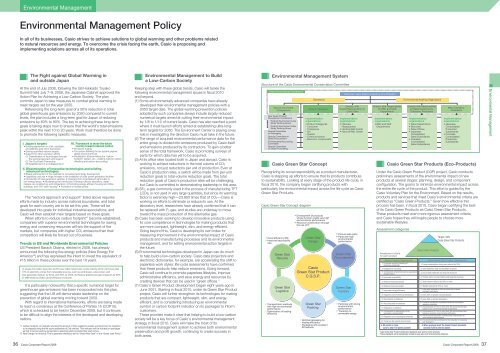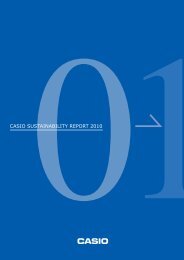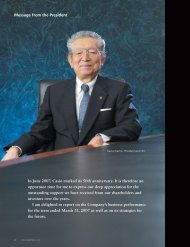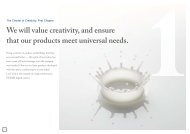Casio Computer Co. Ltd
Corporate Report 2009 all pages - Casio
Corporate Report 2009 all pages - Casio
- No tags were found...
You also want an ePaper? Increase the reach of your titles
YUMPU automatically turns print PDFs into web optimized ePapers that Google loves.
Environmental Management<br />
Environmental Management Policy<br />
In all of its businesses, <strong>Casio</strong> strives to achieve solutions to global warming and other problems related<br />
to natural resources and energy. To overcome the crisis facing the earth, <strong>Casio</strong> is proposing and<br />
implementing solutions across all of its operations.<br />
The Fight against Global Warming in<br />
and outside Japan<br />
At the end of July 2008, following the G8 Hokkaido Toyako<br />
Summit held July 7–9, 2008, the Japanese Cabinet approved the<br />
Action Plan for Achieving a Low-Carbon Society. The plan<br />
commits Japan to take measures to combat global warming to<br />
meet targets set for the year 2050.<br />
Referencing the long-term goal of a 50% reduction in total<br />
global greenhouse gas emissions by 2050 compared to current<br />
levels, the plan includes a long-term goal for Japan of reducing<br />
emissions by 60% to 80%. The key to achieving these long-term<br />
goals is taking steps now to ensure that the world’s total emissions<br />
peak within the next 10 to 20 years. Work must therefore be done<br />
to promote the following specific measures.<br />
I. Japan’s targets<br />
• Building agreement on a fair, equitable,<br />
and effective post-2012 framework<br />
• Setting quantified national targets<br />
• Support for other countries’ efforts<br />
(1) Dissemination of technologies through<br />
the sectoral approach and support<br />
(2) The <strong>Co</strong>ol Earth Partnership<br />
(3) Establishment of a multilateral fund<br />
III. Framework to move the whole<br />
country toward reduced carbon<br />
• Emissions trading<br />
• Tax system (Making the tax system greener,<br />
global environment tax)<br />
• Visualization (Disseminating the “carbon<br />
footprint” system, etc., creating rules for carbon<br />
offsetting and carbon accounting)<br />
II. Dissemination of innovative technologies and existing<br />
advanced technologies<br />
• Steady enforcement of the roadmap to innovative technology development<br />
• Upgrading coal use • Huge increase in the installation of solar power generation facilities<br />
• Introduction of next-generation vehicles • Changing from incandescent light bulbs to<br />
low-energy lamps • Accelerating the introduction of energy-efficient televisions, water<br />
heaters, air-conditioning, and refrigerators • Promoting energy-efficient housing and office<br />
buildings, and “200-year Housing” • Promotion of nuclear power<br />
The “sectoral approach and support” listed above requires<br />
efforts made by industry across national boundaries, and total<br />
goals for each country are to be set this year. These will be<br />
developed into goals for individual industrial associations, and<br />
<strong>Casio</strong> will then establish new targets based on these goals.<br />
When efforts to reduce carbon footprint* 1 become established,<br />
companies with superior environmental technologies for saving<br />
energy and conserving resources will win the support of the<br />
markets, but companies with higher CO2 emissions than their<br />
competitors will likely be forced out of business.<br />
Trends in US and Worldwide Environmental Policies<br />
US President Barack Obama, elected in 2008, has already<br />
announced the following five energy policies (New Energy For<br />
America* 2 ) and has expressed the intent to invest the equivalent of<br />
¥15 trillion in these policies over the next 10 years.<br />
(1) Create five million new jobs; (2) Put one million hybrid cars on the road by 2015; (3) Ensure that<br />
10% of electricity comes from renewable sources, such as wind power, solar power, and<br />
next-generation biofuel, by 2012, and 25% by 2025; (4) Reduce greenhouse gas emissions by 80%<br />
of 1990 levels by 2050; and (5) Reduce oil imports<br />
It is particularly noteworthy that a specific numerical target for<br />
greenhouse gas emissions has been incorporated into this plan,<br />
suggesting that the US will demonstrate leadership on the<br />
prevention of global warming moving toward 2050.<br />
With regard to international frameworks, efforts are being made<br />
to reach a consensus at the <strong>Co</strong>nference of Parties 15 (COP15),<br />
which is scheduled to be held in December 2009, but it continues<br />
to be difficult to align the interests of the developed and developing<br />
nations.<br />
*1. Carbon footprint: An indicator showing the amount of CO2 needed to sustain a product from its inception<br />
to its disposal using the life-cycle assessment (LCA) method. This indicator will be included on packages<br />
so that it can be used by consumers in selecting which products they want to buy.<br />
*2. New Energy For America: This is generally referred to as the “Green New Deal” or the “Green Jobs Policy.”<br />
Environmental Management to Build<br />
a Low-Carbon Society<br />
Keeping step with these global trends, <strong>Casio</strong> will tackle the<br />
following environmental management issues in fiscal 2010<br />
and beyond.<br />
(1) Some environmentally advanced companies have already<br />
developed their environmental management policies with a<br />
2050 target date. The global warming prevention policies<br />
adopted by such companies always include largely reduced<br />
numerical targets aimed at cutting their environmental impact<br />
by 1/8 to 1/10 of current levels. <strong>Casio</strong> has also reached a point<br />
where it must launch efforts aimed at establishing ultra-longterm<br />
targets for 2050. The Environment Center is playing a key<br />
role in investigating the direction <strong>Casio</strong> must take in the future.<br />
(2) The range of acquired environmental performance data for the<br />
entire group is divided into emissions produced by <strong>Casio</strong> itself<br />
and emissions produced by its contractors. To gain a better<br />
sense of the total framework, <strong>Casio</strong> is promoting surveys of<br />
parts for which data has yet to be acquired.<br />
(3) At its office sites located both in Japan and abroad, <strong>Casio</strong> is<br />
working to achieve reductions in the total volume of CO2<br />
emissions, not just reductions per unit of production. Even at<br />
<strong>Casio</strong>’s production sites, a switch will be made from per-unit<br />
reduction goals to total-volume reduction goals. The total<br />
reduction goals of <strong>Casio</strong>’s production sites will be challenging,<br />
but <strong>Casio</strong> is committed to demonstrating leadership in this area.<br />
(4) SF6, a gas commonly used in the process of manufacturing TFT<br />
LCDs, is not used in very large quantities, but since its warming<br />
factor is extremely high—23,900 times that of CO2—<strong>Casio</strong> is<br />
working on efforts to eliminate or reduce its use. At the<br />
laboratory level, researchers have already confirmed that it can<br />
be replaced with F2 gas, and studies are underway to move<br />
toward the mass production of this alternative gas.<br />
(5) <strong>Casio</strong> has been working to develop innovative products using<br />
its core competence in technologies for making products that<br />
are more compact, lightweight, slim, and energy-efficient.<br />
Going beyond this, <strong>Casio</strong> is developing its own index for<br />
measuring improvement in the environmental impact of <strong>Casio</strong><br />
products and manufacturing processes and its environmental<br />
management, and for setting environmental action targets in<br />
the future.<br />
(6) Environmental technologies developed in Japan can do much<br />
to help build a low-carbon society. <strong>Casio</strong> data projectors and<br />
electronic dictionaries, for example, are accelerating the shift to<br />
paperless work styles: life-cycle assessments have confirmed<br />
that these products help reduce emissions. Going forward,<br />
<strong>Casio</strong> will continue to promote paperless lifestyles, improve<br />
administrative efficiency, and save energy and resources by<br />
creating devices that can be used in “green offices.”<br />
(7) <strong>Casio</strong>’s Green Product development began eight years ago in<br />
June 2001. Starting in fiscal 2010, under its Green Star Product<br />
project, <strong>Casio</strong> will further strengthen its technologies for making<br />
products that are compact, lightweight, slim, and energyefficient,<br />
and is considering introducing an environmental<br />
symbol or carbon footprint indicator on its packages to inform<br />
customers.<br />
These priorities make it clear that helping to build a low-carbon<br />
society will be a key focus of <strong>Casio</strong>’s environmental management<br />
strategy in fiscal 2010. <strong>Casio</strong> will make the most of its<br />
environmental management system to achieve both environmental<br />
preservation and profit growth, continuing to create success in<br />
both areas.<br />
Environmental Management System<br />
Structure of the <strong>Casio</strong> Environmental <strong>Co</strong>nservation <strong>Co</strong>mmittee<br />
<strong>Casio</strong> Environmental <strong>Co</strong>nference<br />
Special <strong>Co</strong>mmittee<br />
Chairpersons<br />
Secretariat<br />
Division Managers<br />
<br />
New Green Product<br />
Development <strong>Co</strong>nference<br />
Product Environment Laws<br />
Study Working Group<br />
Product Environment Index<br />
Study Working Group<br />
Special <strong>Co</strong>mmittee<br />
on Packaging<br />
Special <strong>Co</strong>mmittee on<br />
Green Procurement<br />
Environmental Accounting<br />
<strong>Co</strong>mmittee<br />
Special <strong>Co</strong>mmittee<br />
on Green Purchasing<br />
Implementation<br />
organizations<br />
• Product Categories<br />
• <strong>Co</strong>nsumer<br />
• Timepieces<br />
• QV<br />
• System<br />
• <strong>Co</strong>mmunications<br />
• Electronic components<br />
<strong>Casio</strong> Green Star <strong>Co</strong>ncept<br />
Director with<br />
Overall Responsibility for<br />
<strong>Casio</strong> Sites<br />
Implementation<br />
organizations<br />
• Hatsudai<br />
Headquarters<br />
• Hachioji R&D Center<br />
• Hamura R&D Center<br />
Recognizing its social responsibility as a product manufacturer,<br />
<strong>Casio</strong> is stepping up efforts to ensure that its products contribute<br />
to sustainability. Looking at every stage of the product life cycle, in<br />
fiscal 2010, the company began certifying products with<br />
particularly low environmental impact across the life cycle as <strong>Casio</strong><br />
Green Star Products.<br />
<strong>Casio</strong> Green Star <strong>Co</strong>ncept diagram<br />
• Good efficiency 3Rs<br />
• Improved recyclability<br />
rate<br />
Green Star<br />
Recycle<br />
Green Star<br />
Logistics<br />
• Transportation methods<br />
with high environmental<br />
performance<br />
• Optimization of loading<br />
efficiency<br />
• Development of products<br />
whose function yields very high<br />
environmental performance<br />
• Resource conservation through<br />
the use of IT<br />
Green Star<br />
Design<br />
<strong>Casio</strong><br />
Green Star Product<br />
C.G.S.P.<br />
Green Star<br />
Packing<br />
• Optimal packaging for<br />
loading efficiency<br />
• Packaging with excellent<br />
3R features<br />
Chairman: Yukio Kashio, Executive Vice President<br />
• Procure safe parts<br />
• Parts with high<br />
environmental<br />
performance<br />
Green Star<br />
Procurement<br />
Green Star<br />
Factory<br />
• Factories with strong<br />
environmental<br />
performance<br />
• Transition to<br />
renewable energy<br />
Director with Responsibility<br />
for R&D and Staff<br />
Departments<br />
Implementation<br />
organizations<br />
• R&D and Staff<br />
Departments<br />
Environmental Auditing Organization<br />
Director with Responsibility<br />
for Sales Departments,<br />
Subsidiary Presidents<br />
Implementation<br />
organizations<br />
• Sales Departments<br />
• Branches<br />
• Sales Offices<br />
• Japanese<br />
<strong>Co</strong>nsolidated<br />
Sales Subsidiaries<br />
• Overseas<br />
<strong>Co</strong>nsolidated<br />
Sales Subsidiaries<br />
Main Subsidiary<br />
Presidents<br />
Implementation<br />
organizations<br />
• Japanese<br />
<strong>Co</strong>nsolidated<br />
Production<br />
Subsidiaries<br />
• Overseas<br />
<strong>Co</strong>nsolidated<br />
Production<br />
Subsidiaries<br />
<strong>Casio</strong> Green Star Products (Eco-Products)<br />
Under the <strong>Casio</strong> Green Product (CGP) project, <strong>Casio</strong> conducts<br />
preliminary assessments of the environmental impact of new<br />
products at several stages: planning, design, and component<br />
configuration. The goal is to minimize environmental impact across<br />
the entire life cycle of the product. This effort is guided by the<br />
<strong>Casio</strong> Voluntary Plan for the Environment. Based on the results,<br />
products and services that meet <strong>Casio</strong>’s environmental criteria are<br />
certified as “<strong>Casio</strong> Green Products.” Given how effective this<br />
process has been, in fiscal 2010, <strong>Casio</strong> began certifying the best<br />
of its <strong>Casio</strong> Green Products as <strong>Casio</strong> Green Star Products.<br />
These products meet even more rigorous assessment criteria,<br />
and <strong>Casio</strong> hopes they will inspire people to choose more<br />
sustainable lifestyles.<br />
Assessment categories<br />
*<strong>Casio</strong> Green Star Product certification standards may vary for some products.<br />
*These standards will be periodically revised to keep pace with environmental advances.<br />
Target: 30%<br />
<strong>Casio</strong> Green Star Products<br />
<strong>Casio</strong> Green Products<br />
Assessment criteria<br />
for each product<br />
Green Product Assessment<br />
<strong>Casio</strong> Green Star Product Assessment<br />
1. Promotes recycling (labeling of<br />
materials contained)<br />
1. Power consumption during use reduced by 20%<br />
2. Designed for recycling<br />
2. Solar batteries used and Eco Mark acquired<br />
3. <strong>Co</strong>mponents of products can be separated,<br />
disassembled<br />
3. Use of solar batteries and long-life structure<br />
4. Improved recyclability<br />
4. <strong>Co</strong>mes with a 10-year battery and long-life structure<br />
5. Reduced resource volume<br />
6. Reduced resource weight<br />
7. Improved energy efficiency<br />
8. Regulated use of chemical substances<br />
9. Recyclability of batteries<br />
10. Recycling label on batteries<br />
11. Regulatory compliance<br />
12. <strong>Co</strong>mponents of packaging can be<br />
separated, disassembled<br />
13. Regulated use of packaging materials<br />
14. Preserves the natural environment<br />
• 90 points or more,<br />
out of a total 100 points possible<br />
5. Body volume reduced by 20% or more<br />
6. Weight reduced by 20% or more<br />
7. Load ratio reduced by 20% or more due to more<br />
compact packaging<br />
8. Uses 30% or greater recycled plastic<br />
9. Uses 25% or greater bioplastics<br />
10. <strong>Co</strong>ntains no specific hazardous chemical substances<br />
(polyvinyl chloride)<br />
11. Improvement of 10% or more over the conventional ratio<br />
based on an LCA environmental assessment<br />
12. Improvement of 10% or more over the conventional ratio<br />
based on product environmental efficiency<br />
13. Has functions that make considerable contributions to<br />
environmental performance<br />
14. Has functions that contribute to the reduction in resource<br />
use through IT<br />
• When products meet the Green Product standards<br />
and also fulfill a criterion above.<br />
Environmental Management<br />
36 <strong>Casio</strong> <strong>Co</strong>rporate Report 2009 <strong>Casio</strong> <strong>Co</strong>rporate Report 2009 37







